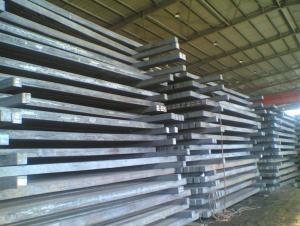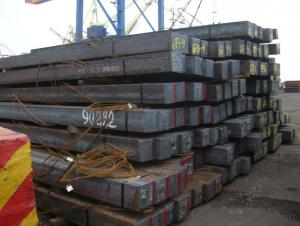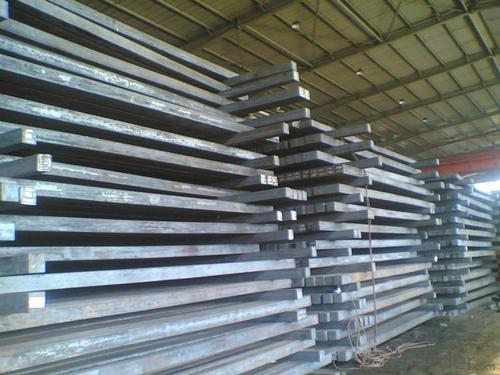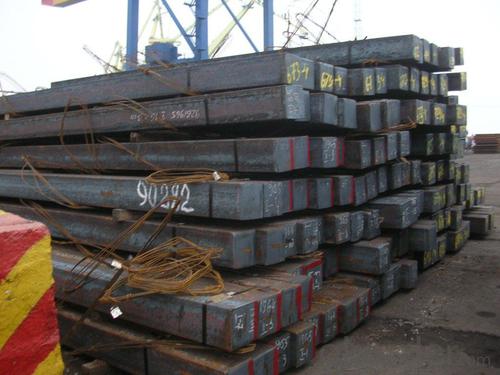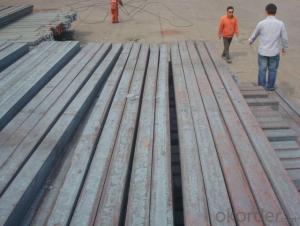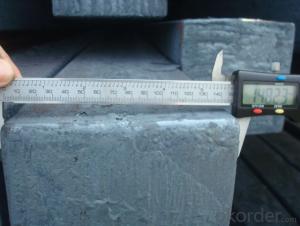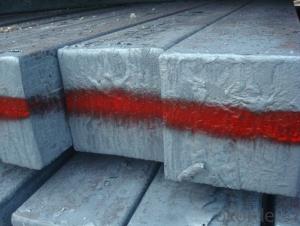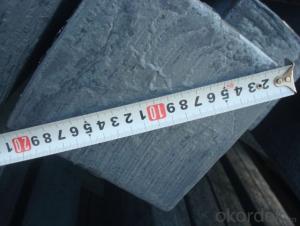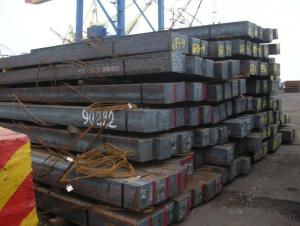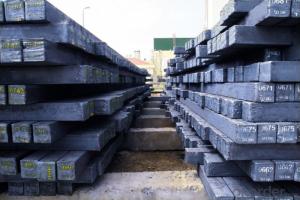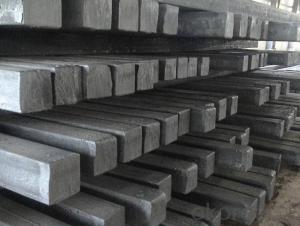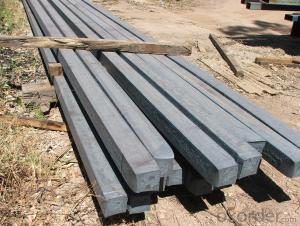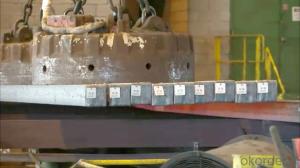Hot Rolled Steel Billet 3SP Standard 195mm
- Loading Port:
- Shanghai
- Payment Terms:
- TT OR LC
- Min Order Qty:
- 100 m.t.
- Supply Capability:
- 10000 m.t./month
OKorder Service Pledge
OKorder Financial Service
You Might Also Like
Structure of Hot Rolled Steel Billet 3SP Standard 195mm

Description of Hot Rolled Steel Billet 3SP Standard 195mm
Prepainted Rolled steel Coil is a kind of coated steel coil/sheet. With the cold rolled steel of different strength and thickness as substrate, it is produced through applying Al-Zn coat on both faces by hot dip process. In its coating, Al accounts for about 55%, Si 1.6%, while the remaining is Zn. Aluminum zinc coils enjoys both the physical protective feature and durability of Al and the electrochemical protective property of Zn. And its surface has bright silver color and regular embossed-like figure, which are highly decorative. RAL Scale Z35 Prepainted Rolled Steel Coil for Construction Roofing

Main Feature of Hot Rolled Steel Billet 3SP Standard 195mm
1.Corrosion resistance: It mainly depends on the zinc protection. When the zinc being worn,
2. Heat resistance: steel sheet has excellent heat resistance, can withstand high temperatures over 300 centigrade, and is similar with aluminized steel high temperature oxidation resistance. It often used in chimney pipes, ovens, fluorescent lighting device and the device cover.
3. Heat reflective: Galvanized steel plate heat-reflective high rate is twice as galvanized steel, often used to make insulation materials. RAL Scale Z35 Prepainted Rolled Steel Coil for Construction Roofing
Applications of Hot Rolled Steel Billet 3SP Standard 195mm
1. Construction and building: roofing; ventilating duct; handrail; partition panel;etc.
2. Electric appliance: refrigerator; washing machine; refrigerator; DVD;etc.
3.Transportation: oil tank; gas tank;road sign; etc.
4.Agriculture constructions :barn; etc.RAL Scale Z35 Prepainted Rolled Steel Coil for Construction Roofing
5.Others:vending machine; game machine; auto parts spare parts etc.
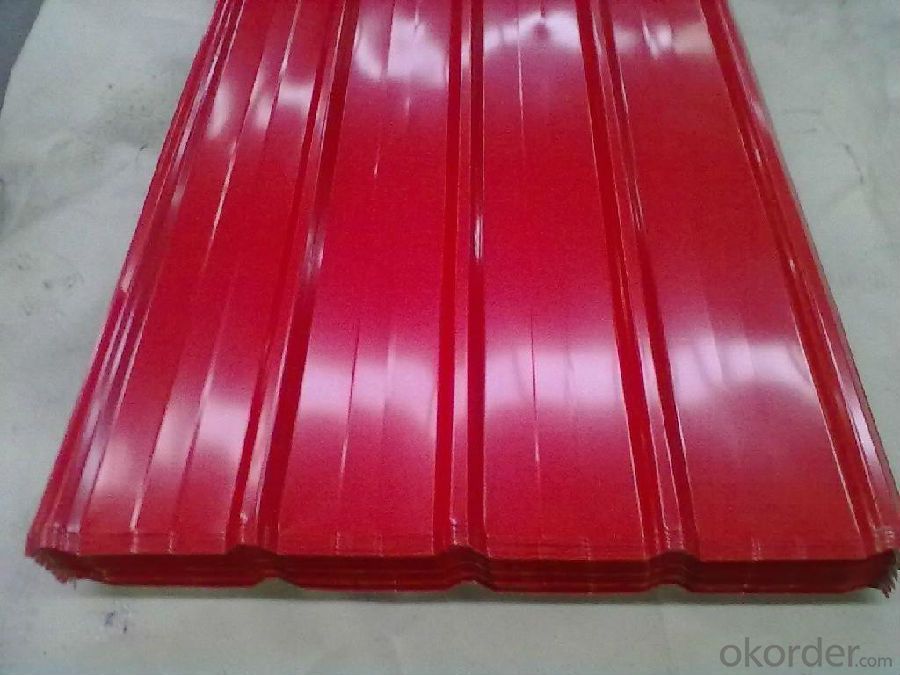
Specifications of Hot Rolled Steel Billet 3SP Standard 195mm
Product | Hot Rolled Steel Billet 3SP Standard 115mm |
Material Grade | SGCC / SGCH / DX51D+AZ, etc |
Thickness | 0.5-3.0mm |
Width | 700-1500mm |
Tolerance | Thickness: +/-0.02mm , Width:+/-2mm |
Zinc-coating | AZ30-150g/m2 |
Technique | Raw material: Hot rolled steel coil --> Cold rolled_>hot dipped galvalume |
Surface | Dried, Chromated, Unoiled,RAL Scale Z35 Prepainted Rolled Steel Coil for Construction Roofing |
Spangle | Regular spangle , small spangle, zero spangle |
ID | 508MM 610MM |
Coil weight | 25MT max |
Export package | Cardboard inner sleeves, Waterproof paper, galvanized steel covered and steel strip packed |
FAQ of Hot Rolled Steel Billet 3SP Standard 195mm
We have organized several common questions for our clients,may help you sincerely:
1. What is the minimum order quantity ?
Our MOQ is 100 mt for each size each specification. Usually we can offer discount if can buy large QTY once. RAL Scale Z35 Prepainted Rolled Steel Coil for Construction Roofing
2. How long can we receive the product after ordering?
Our general delivery time is 30 days after confirmation, but so some special orders, we have offer special delivery time
3. How to guarantee the quality of the products?
We have established the international advanced quality management system ,every link from raw material to final product we have strict quality test;We resolutely put an end to unqualified products flowing into the market. At the same time, we will provide necessary follow-up service assurance.
4. What is the payment?
We accept T/T, L/C
- Q: How are steel billets shaped into other forms?
- Steel billets are shaped into other forms through a process called hot or cold working. In hot working, the billets are heated to high temperatures and then shaped using various methods like rolling, forging, or extrusion. Cold working involves shaping the billets at room temperature through processes such as drawing, bending, or pressing. These techniques allow the steel billets to be transformed into different shapes and sizes according to the desired end product.
- Q: What are the different types of surface finishes available for steel billets?
- The different types of surface finishes available for steel billets include hot rolled, cold rolled, pickled and oiled, and galvanized finishes.
- Q: How are steel billets distributed in the market?
- Steel billets are distributed in the market through various channels and processes. These channels can be broadly categorized into three main methods: direct sales, through distribution networks, and online platforms. Direct sales involve manufacturers or steel mills selling their billets directly to customers, such as construction companies, fabricators, or steel service centers. This method allows manufacturers to have better control over pricing, quality, and delivery schedule. It also enables them to build direct relationships with customers and understand their specific requirements. Distribution networks play a significant role in the distribution of steel billets. These networks consist of wholesalers, distributors, and stockists who purchase steel billets from manufacturers and sell them to end-users or smaller retailers. Distribution networks have extensive market reach, allowing them to cater to a wide geographical area. They provide convenience to customers by maintaining an inventory of steel billets, ensuring timely availability and reducing lead times. In recent years, online platforms have emerged as a popular method for distributing steel billets. Online trading platforms connect buyers and sellers of steel billets, providing a convenient and efficient way to conduct business transactions. These platforms allow manufacturers to reach a global customer base, while buyers can access a wide range of suppliers and compare prices and specifications. Online platforms also provide transparency and reduce the need for intermediaries, resulting in cost savings. Regardless of the distribution method, the logistics of steel billets' transportation and storage are crucial. Steel billets are typically transported in bulk using various modes of transportation, including trucks, trains, or ships. To ensure the quality and integrity of the billets, proper storage facilities are necessary, which include warehouses or yards equipped with cranes and heavy-duty machinery. Overall, the distribution of steel billets involves a complex network of manufacturers, distributors, and online platforms, all working together to meet the diverse needs of customers. This ensures a steady supply of steel billets in the market, supporting various industries such as construction, manufacturing, and infrastructure development.
- Q: How are steel billets used in the production of valves?
- Steel billets are used in the production of valves as a raw material. They are melted and then shaped into the desired shape and size of the valve through various manufacturing processes such as forging, machining, and heat treatment. The steel billets provide the necessary strength and durability required for valves to withstand high pressure and temperature conditions.
- Q: What are the different welding techniques used for steel billets?
- There are several different welding techniques that can be used for steel billets, depending on the specific requirements and desired outcome of the project. Some of the most commonly used techniques include: 1. Shielded Metal Arc Welding (SMAW): Also known as stick welding, SMAW is a versatile and widely used welding technique. It involves using a consumable electrode coated in flux, which provides a shielding gas to protect the weld pool from atmospheric contamination. SMAW can be used for both thick and thin steel billets and is suitable for various applications. 2. Gas Metal Arc Welding (GMAW): GMAW, also known as MIG (Metal Inert Gas) welding, is a popular technique for welding steel billets. It uses a continuous wire electrode and a shielding gas to protect the weld pool. GMAW is known for its high productivity and is often used for welding thin to medium steel billets. 3. Flux-Cored Arc Welding (FCAW): FCAW is similar to GMAW but uses a tubular electrode filled with flux instead of a solid wire. The flux provides a shielding gas and can also contain additional alloying elements. FCAW is commonly used for welding thick steel billets and in outdoor or windy environments where shielding gas could be easily blown away. 4. Gas Tungsten Arc Welding (GTAW): GTAW, also known as TIG (Tungsten Inert Gas) welding, is a precise and versatile technique frequently used for high-quality welds on steel billets. It utilizes a non-consumable tungsten electrode and a separate filler material if needed. GTAW produces clean and precise welds but is slower compared to other techniques. 5. Submerged Arc Welding (SAW): SAW is a welding process that involves the formation of an arc between a continuously fed wire electrode and the steel billet. The arc is shielded by a granular flux, which also provides additional alloying elements and protects the weld pool. SAW is commonly utilized for welding thick steel billets, such as in the manufacturing of large structures or pipes. Each of these welding techniques has its advantages and disadvantages, and the choice of technique depends on factors such as the type and thickness of the steel billet, desired weld quality, productivity, and environmental conditions. It is crucial to select the appropriate welding technique and ensure proper training and safety precautions are followed to achieve successful and durable welds on steel billets.
- Q: How are steel billets stored?
- To safeguard steel billets from corrosion and other harm, they are commonly stored in a controlled environment. The approach to storage varies based on billet size, quantity, and the specific requirements of the steel producer. One frequently employed method involves horizontally stacking the billets on a flat surface, such as a concrete floor or specialized steel racks. The billets are arranged in rows and columns, leaving sufficient space for easy access and inspection. To ward off corrosion, the billets are typically coated with a protective layer, such as oil or rust inhibitors, before being stored. Furthermore, the storage area may be equipped with dehumidifiers or climate control systems to maintain optimal humidity levels and prevent moisture-related damage. For larger quantities, vertical storage in specialized racks or bins is an option. This allows for efficient space utilization and facilitates handling with the aid of machinery like cranes and forklifts. These vertical storage systems are designed to distribute the weight of the billets evenly, thus preventing deformation or damage. Regardless of the chosen storage method, regular inspection is crucial to identify any signs of damage or deterioration, such as rust, cracks, or other defects that may impact the steel's quality. Proper documentation and inventory management are also essential for efficient retrieval and use of the billets. In summary, the storage of steel billets prioritizes their protection and preservation. By adhering to appropriate storage practices, steel manufacturers can uphold the billets' quality and ensure their suitability for subsequent manufacturing processes.
- Q: Can steel billets be heat treated for increased hardness?
- Yes, steel billets can be heat treated to increase hardness. Heat treatment processes such as quenching and tempering can be used to alter the microstructure of the steel, resulting in improved hardness and other mechanical properties.
- Q: How are steel billets used in the manufacturing of automotive components?
- Steel billets are an essential raw material used in the manufacturing of automotive components. These billets are semi-finished products that are shaped into various forms to create the necessary components. Firstly, steel billets are heated to a specific temperature to make them malleable and easier to work with. Once they reach the desired temperature, they are placed into a mold or die and subjected to intense pressure to shape them into the desired form. This process is known as forging. Automotive components such as engine parts, gears, axles, and suspension components require high strength and durability. Steel billets are preferred for these applications due to their excellent mechanical properties, including high tensile strength, toughness, and wear resistance. After the forging process, the shaped billets are further processed through various techniques such as machining, heat treatment, and surface finishing to achieve the final specifications required by automotive manufacturers. These processes ensure that the components meet the necessary performance standards, dimensional accuracy, and surface quality. The use of steel billets in the manufacturing of automotive components offers several advantages. Steel is readily available, cost-effective, and has a high recycling rate, making it an environmentally friendly choice. Additionally, steel's versatility allows for a wide range of component designs and customization options to meet specific automotive requirements. In conclusion, steel billets play a crucial role in the manufacturing of automotive components. Their malleability and excellent mechanical properties make them an ideal raw material for forging processes, enabling the production of high-strength and durable components used in various automotive applications.
- Q: How are steel billets used in the production of shipbuilding materials?
- Steel billets play a vital role in shipbuilding materials as they are necessary for producing strong and durable components. Shipbuilding requires materials that can withstand harsh marine conditions, and steel billets fulfill these requirements. To begin with, steel billets are utilized in the production of different types of steel plates. These plates form the basis of shipbuilding materials and are customized according to specific design needs, such as hull plating, bulkheads, decks, and superstructures. Steel billets provide the essential raw material for creating these plates, ensuring they possess the required strength and structural integrity. Furthermore, steel billets are crucial in manufacturing shipbuilding sections and profiles. These sections, including beams, angles, channels, and other structural components, provide support and reinforcement to the ship's structure. Steel billets are heated and shaped through processes like rolling, forging, or extrusion to form these sections. This allows for the creation of custom-shaped sections that seamlessly integrate into the ship's construction. Additionally, steel billets are also used in producing shipbuilding forgings, which are high-strength components requiring exceptional mechanical properties. Forgings are vital for critical ship parts like propeller shafts, rudder components, and engine parts. Steel billets are heated and shaped using forging techniques to create these components, ensuring they possess the necessary strength, toughness, and resistance to fatigue. In conclusion, steel billets are a fundamental raw material extensively used in shipbuilding. They are transformed into various forms such as plates, sections, and forgings, which are then incorporated into the construction of ships. The utilization of steel billets guarantees that shipbuilding materials meet the stringent requirements for strength, durability, and performance in marine environments.
- Q: What are the properties of high-quality steel billets?
- High-quality steel billets are sought after for their desirable properties in various applications. Chiefly, these billets boast a high degree of purity, containing minimal impurities like sulfur, phosphorus, and other non-metallic elements. This purity contributes to the overall strength and performance of the steel. Another crucial property of high-quality steel billets is their uniform internal structure. This means that the grains within the billet are evenly distributed, resulting in consistent mechanical properties throughout the material. This uniformity enhances the steel's strength, toughness, and durability. High-quality steel billets also demonstrate excellent dimensional accuracy. They possess precise and consistent dimensions, which are vital for subsequent processing and manufacturing operations. This dimensional accuracy ensures that the billets can be easily formed, rolled, forged, or machined into their intended final shapes. Moreover, high-quality steel billets exhibit a superior surface finish. They are devoid of defects like cracks, voids, or inclusions on their surfaces. This smooth and defect-free surface allows for better heat transfer, improved corrosion resistance, and an enhanced aesthetic appearance of the final steel products. Lastly, high-quality steel billets showcase excellent metallurgical properties. They possess a well-controlled chemical composition, which determines their specific mechanical and physical characteristics. These properties can be tailored to meet the requirements of different applications, such as high strength, high ductility, or resistance to extreme temperatures. To summarize, high-quality steel billets possess properties such as purity, uniform internal structure, dimensional accuracy, excellent surface finish, and desirable metallurgical properties. These properties make them ideal for a wide range of applications, including the construction, automotive, aerospace, and manufacturing industries.
Send your message to us
Hot Rolled Steel Billet 3SP Standard 195mm
- Loading Port:
- Shanghai
- Payment Terms:
- TT OR LC
- Min Order Qty:
- 100 m.t.
- Supply Capability:
- 10000 m.t./month
OKorder Service Pledge
OKorder Financial Service
Similar products
Hot products
Hot Searches
Related keywords
